TERRITORIAL VARIETIES OF ENGLISH PRONUNCIATION. FUNCTIONAL STYLISTICS AND

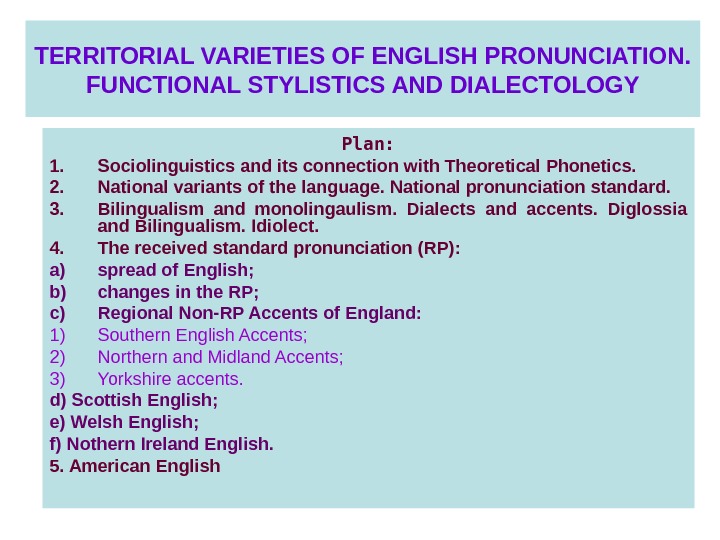
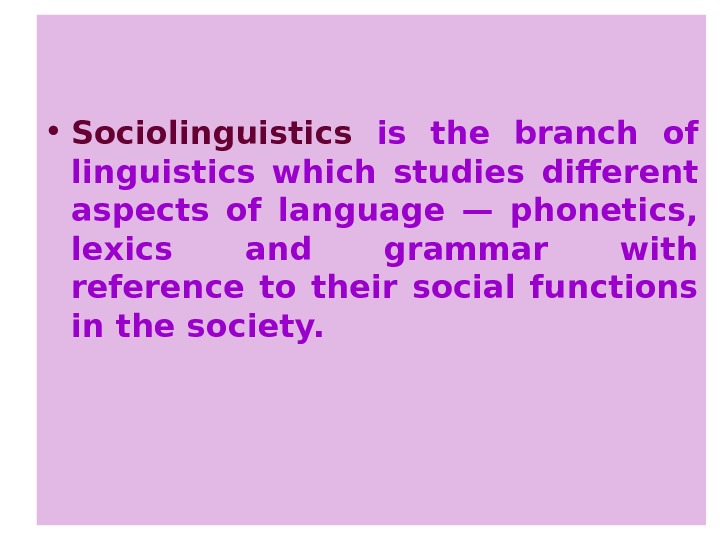
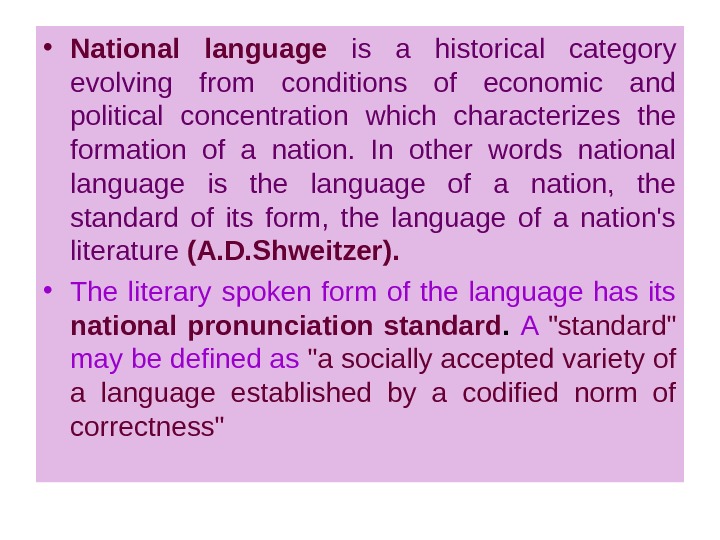
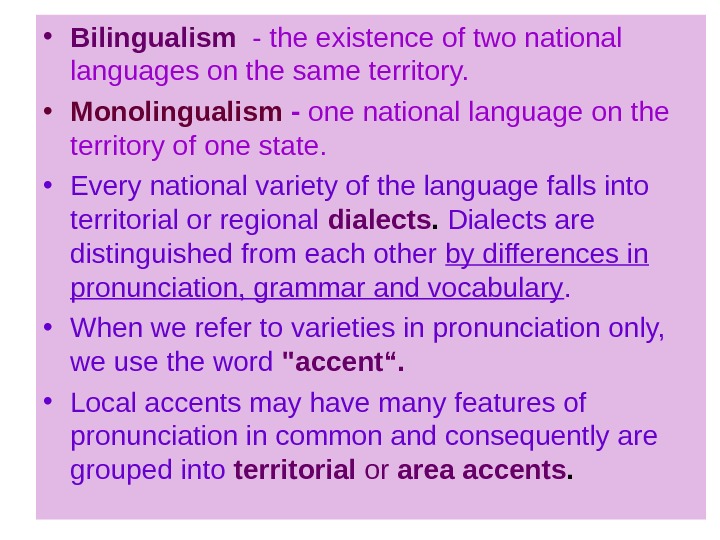
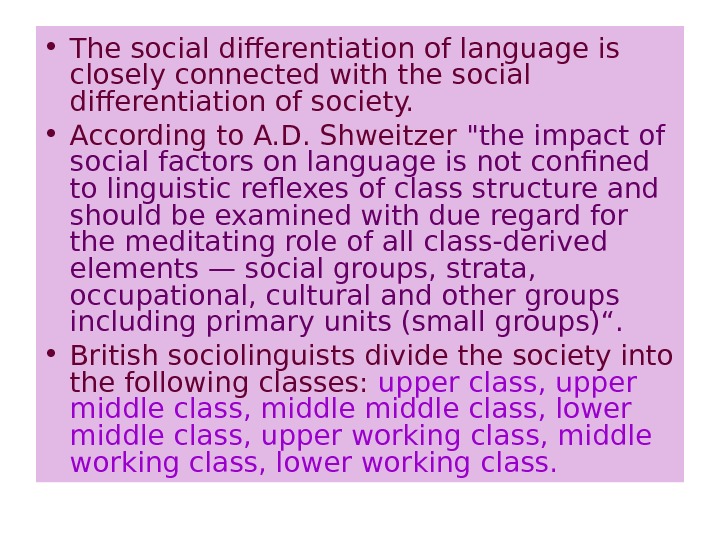
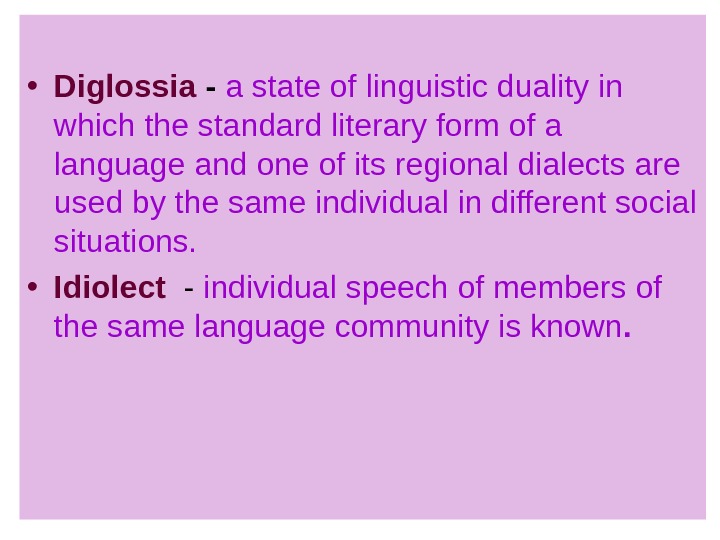
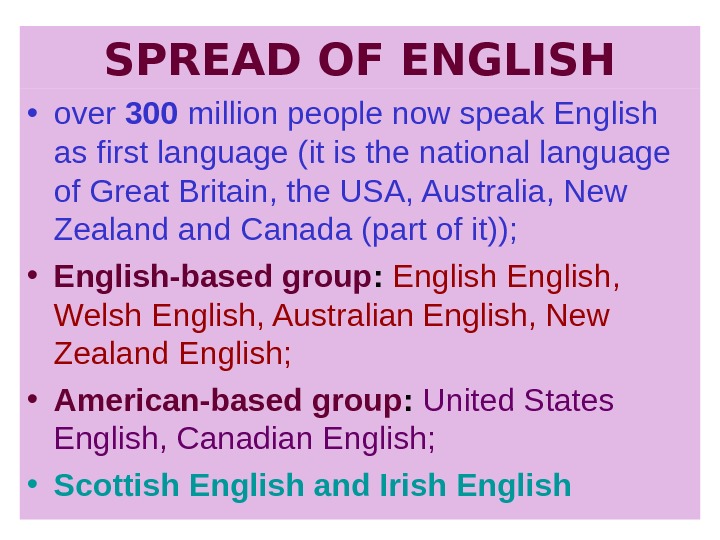
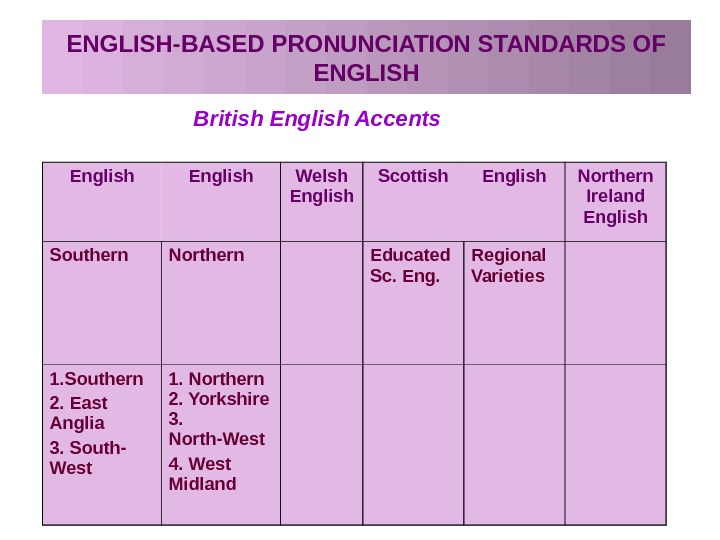
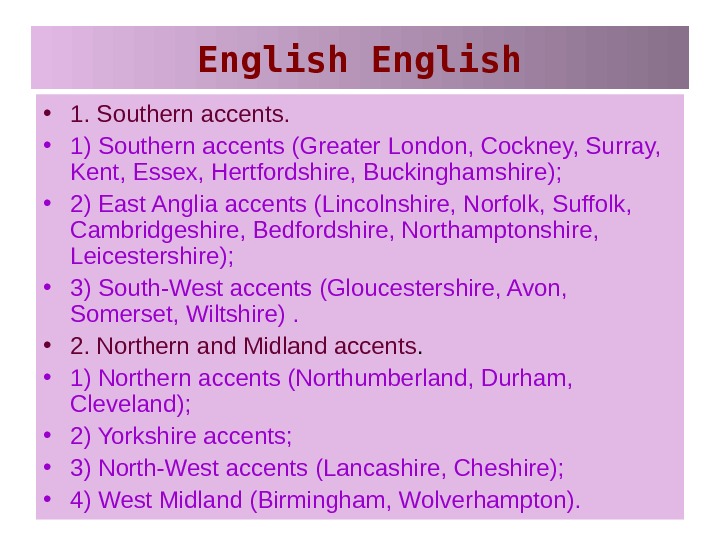
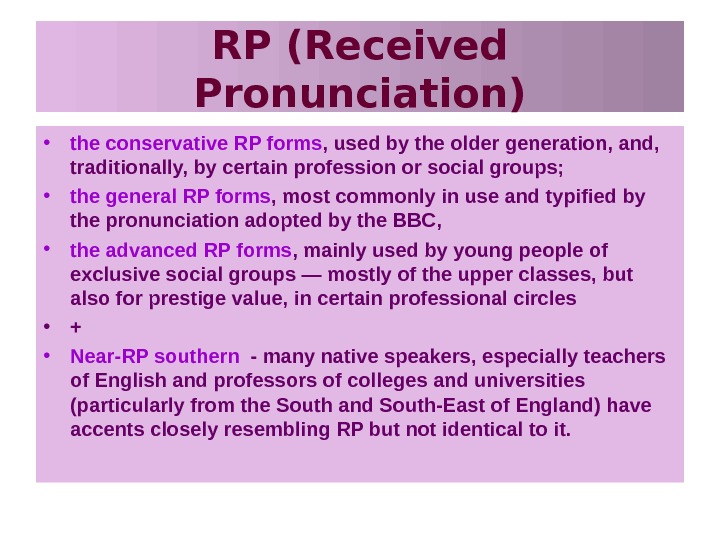
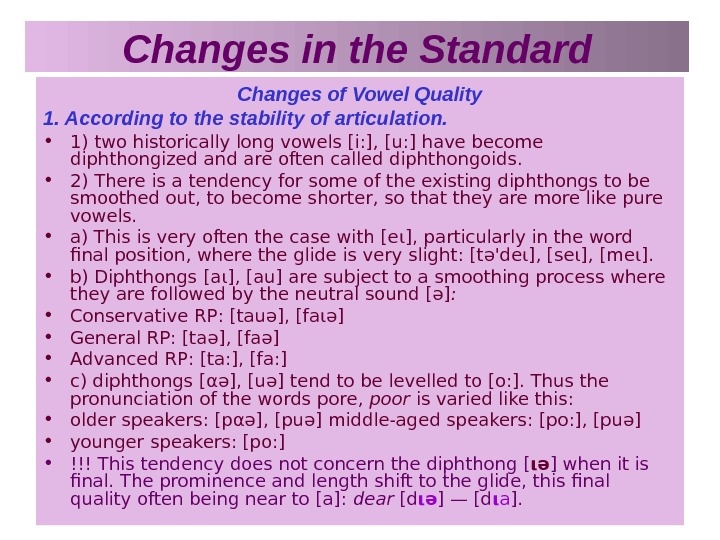
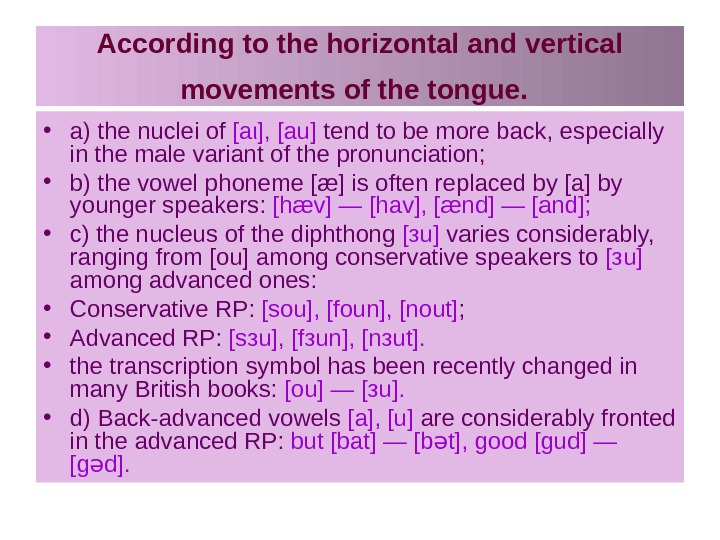
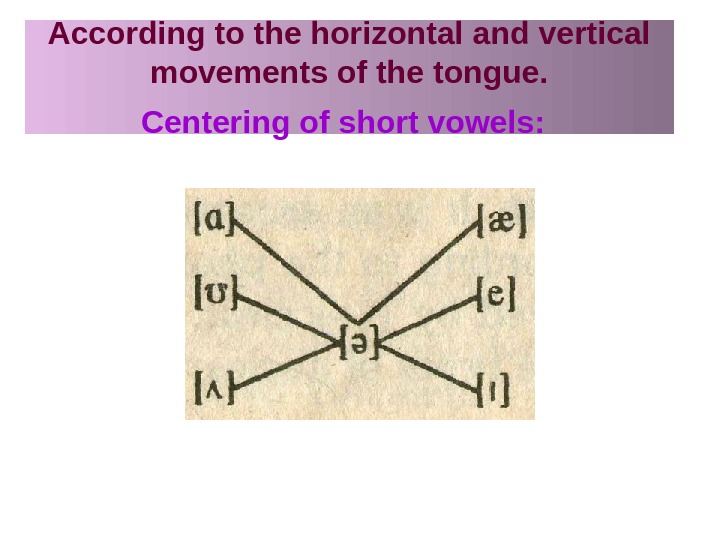
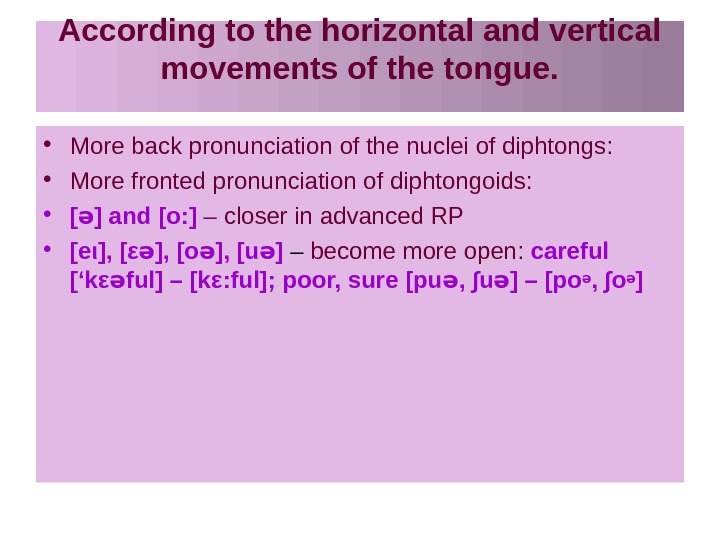
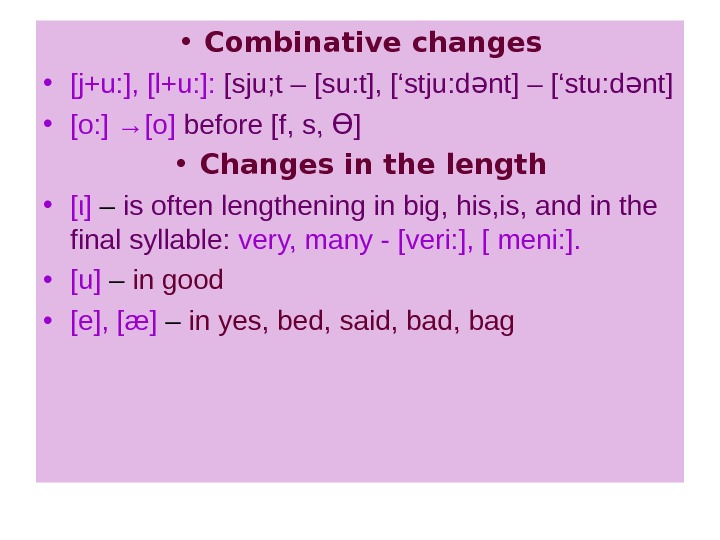
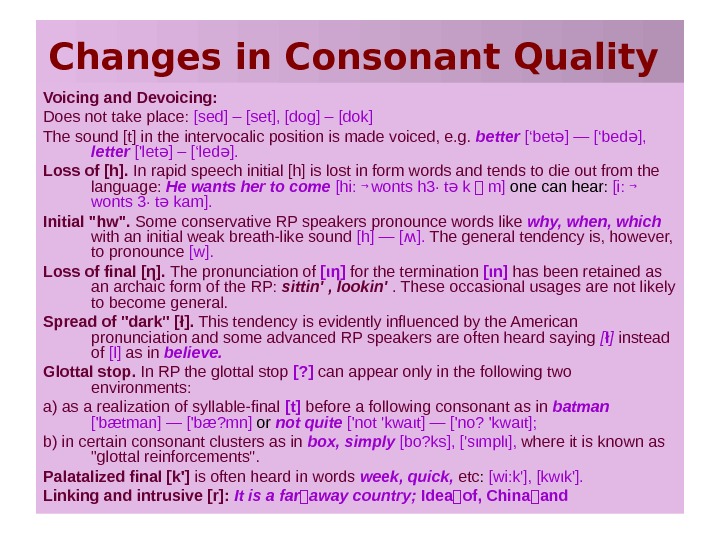
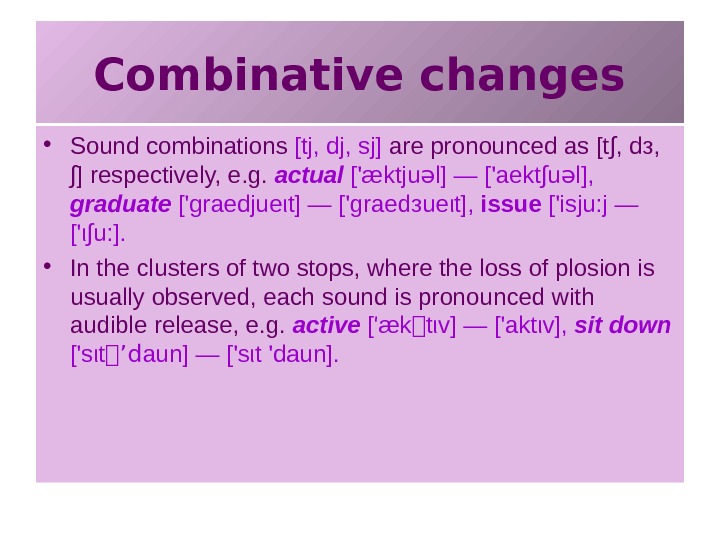
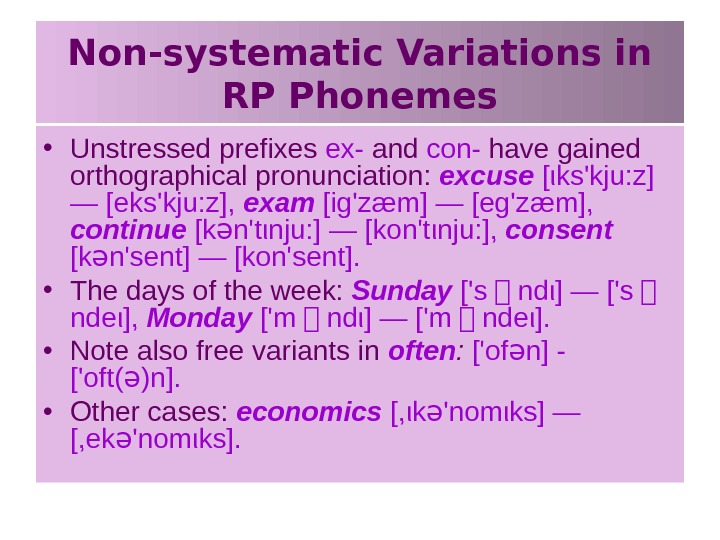
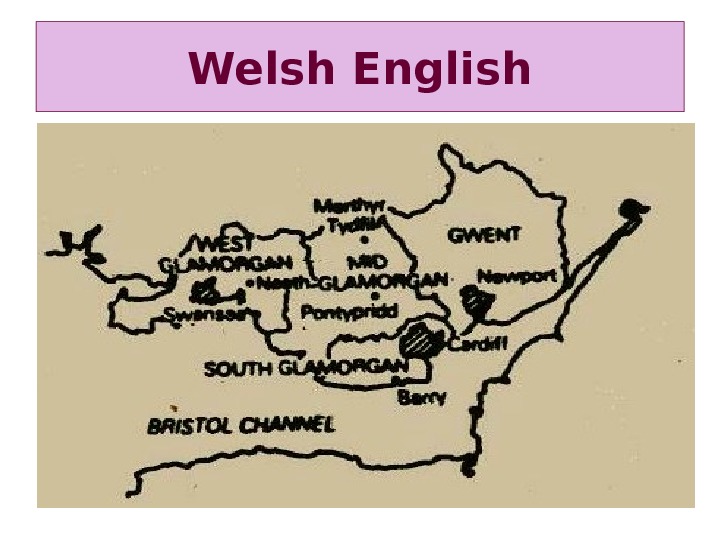
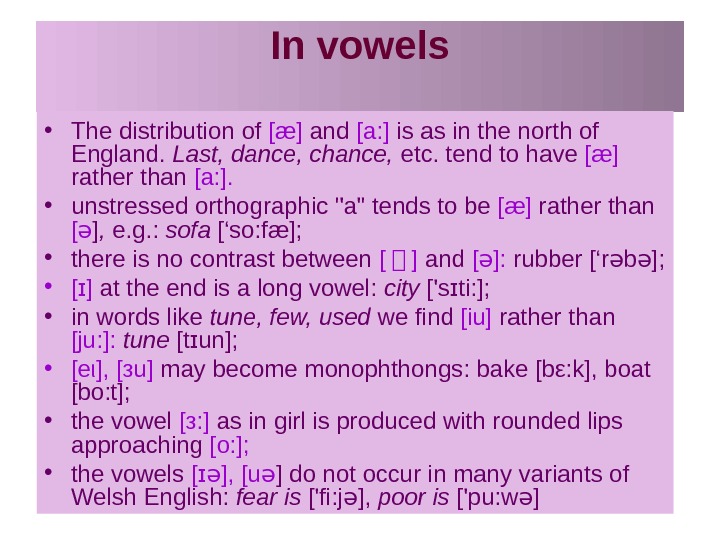
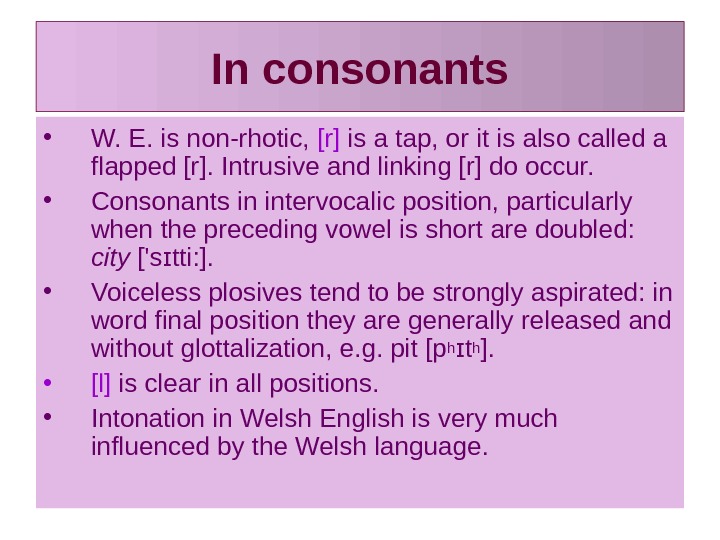
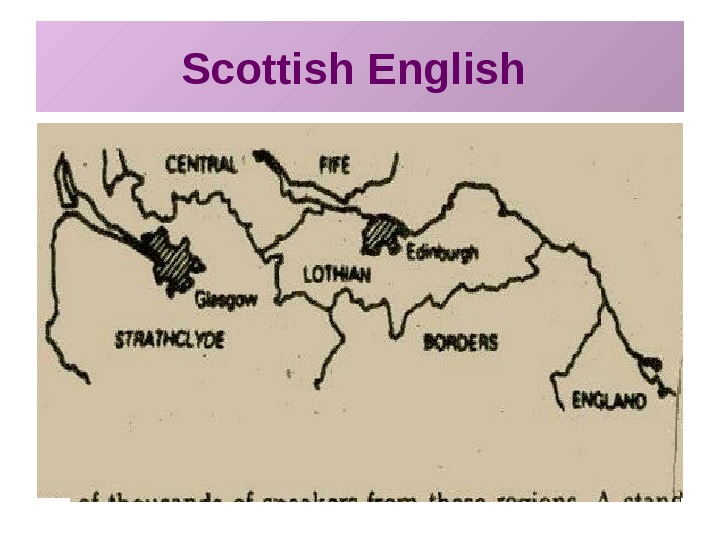
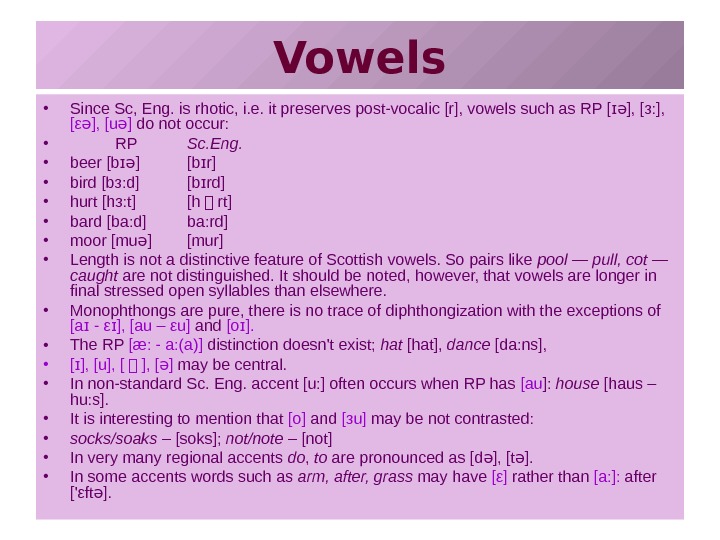
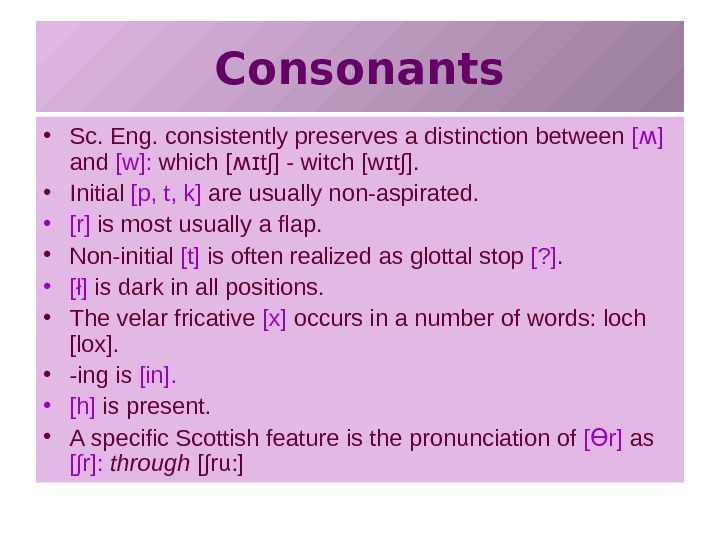
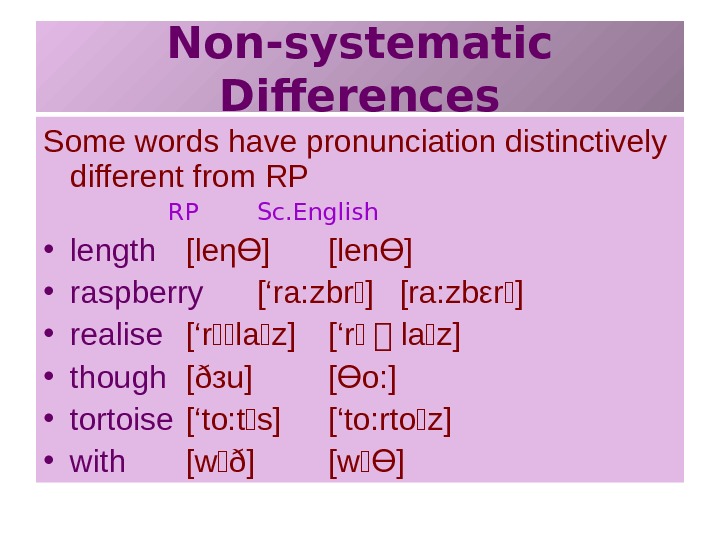


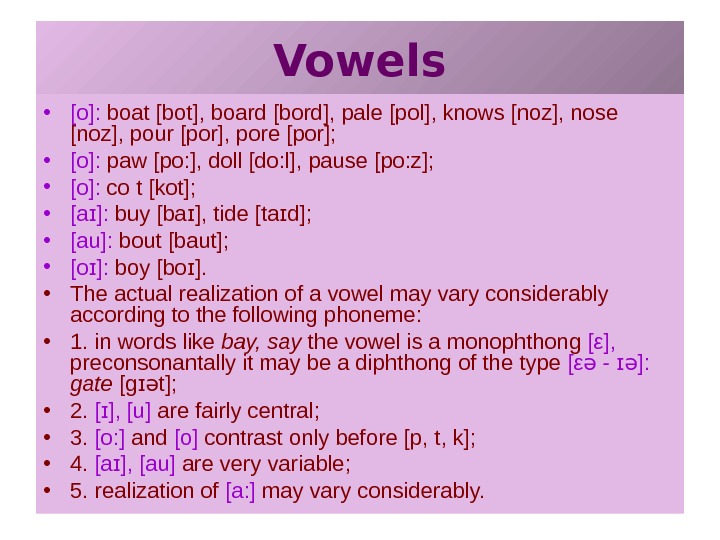
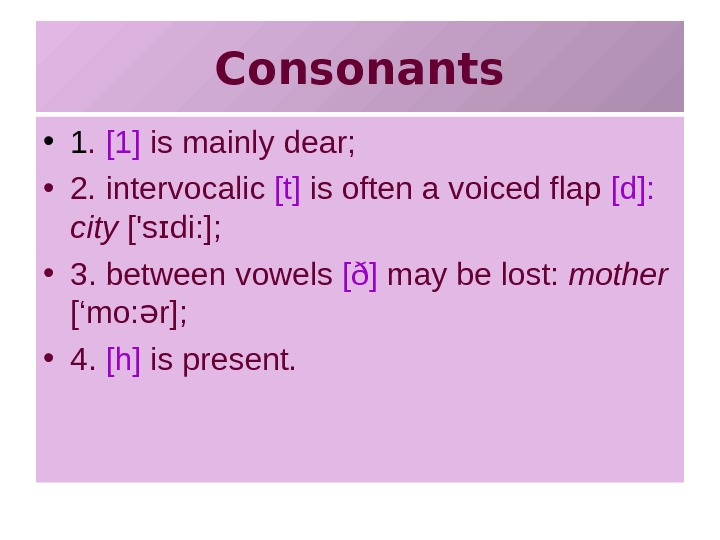
territorial_varieties_of_english_pronunciation.ppt
- Размер: 1.4 Mегабайта
- Количество слайдов: 29
Описание презентации TERRITORIAL VARIETIES OF ENGLISH PRONUNCIATION. FUNCTIONAL STYLISTICS AND по слайдам
 TERRITORIAL VARIETIES OF ENGLISH PRONUNCIATION. FUNCTIONAL STYLISTICS AND DIALECTOLOGY Plan: 1. Sociolinguistics and its connection with Theoretical Phonetics. 2. National variants of the language. National pronunciation standard. 3. Bilingualism and monolingaulism. Dialects and accents. Diglossia and Bilingualism. Idiolect. 4. The received standard pronunciation (RP): a) spread of English; b) changes in the RP; c) Regional Non-RP Accents of England: 1) Southern English Accents; 2) Northern and Midland Accents; 3) Yorkshire accents. d) Scottish English; e) Welsh English; f) Nothern Ireland English. 5. American English
TERRITORIAL VARIETIES OF ENGLISH PRONUNCIATION. FUNCTIONAL STYLISTICS AND DIALECTOLOGY Plan: 1. Sociolinguistics and its connection with Theoretical Phonetics. 2. National variants of the language. National pronunciation standard. 3. Bilingualism and monolingaulism. Dialects and accents. Diglossia and Bilingualism. Idiolect. 4. The received standard pronunciation (RP): a) spread of English; b) changes in the RP; c) Regional Non-RP Accents of England: 1) Southern English Accents; 2) Northern and Midland Accents; 3) Yorkshire accents. d) Scottish English; e) Welsh English; f) Nothern Ireland English. 5. American English
 • Sociolinguistics is the branch of linguistics which studies different aspects of language — phonetics, lexics and grammar with reference to their social functions in the society.
• Sociolinguistics is the branch of linguistics which studies different aspects of language — phonetics, lexics and grammar with reference to their social functions in the society.
 • National language is a historical category evolving from conditions of economic and political concentration which characterizes the formation of a nation. In other words national language is the language of a nation, the standard of its form, the language of a nation’s literature (A. D. Shweitzer). • The literary spoken form of the language has its national pronunciation standard. A «standard» may be defined as «a socially accepted variety of a language established by a codified norm of correctness»
• National language is a historical category evolving from conditions of economic and political concentration which characterizes the formation of a nation. In other words national language is the language of a nation, the standard of its form, the language of a nation’s literature (A. D. Shweitzer). • The literary spoken form of the language has its national pronunciation standard. A «standard» may be defined as «a socially accepted variety of a language established by a codified norm of correctness»
 • Bilingualism — the existence of two national languages on the same territory. • Monolingualism — one national language on the territory of one state. • Every national variety of the language falls into territorial or regional dialects. Dialects are distinguished from each other by differences in pronunciation, grammar and vocabulary. • When we refer to varieties in pronunciation only, we use the word «accent“. • Local accents may have many features of pronunciation in common and consequently are grouped into territorial or area accents.
• Bilingualism — the existence of two national languages on the same territory. • Monolingualism — one national language on the territory of one state. • Every national variety of the language falls into territorial or regional dialects. Dialects are distinguished from each other by differences in pronunciation, grammar and vocabulary. • When we refer to varieties in pronunciation only, we use the word «accent“. • Local accents may have many features of pronunciation in common and consequently are grouped into territorial or area accents.
 • The social differentiation of language is closely connected with the social differentiation of society. • According to A. D. Shweitzer «the impact of social factors on language is not confined to linguistic reflexes of class structure and should be examined with due regard for the meditating role of all class-derived elements — social groups, strata, occupational, cultural and other groups including primary units (small groups)“. • British sociolinguists divide the society into the following classes: upper class, upper middle class, lower middle class, upper working class, middle working class, lower working class.
• The social differentiation of language is closely connected with the social differentiation of society. • According to A. D. Shweitzer «the impact of social factors on language is not confined to linguistic reflexes of class structure and should be examined with due regard for the meditating role of all class-derived elements — social groups, strata, occupational, cultural and other groups including primary units (small groups)“. • British sociolinguists divide the society into the following classes: upper class, upper middle class, lower middle class, upper working class, middle working class, lower working class.
 • Diglossia — a state of linguistic duality in which the standard literary form of a language and one of its regional dialects are used by the same individual in different social situations. • Idiolect — individual speech of members of the same language community is known.
• Diglossia — a state of linguistic duality in which the standard literary form of a language and one of its regional dialects are used by the same individual in different social situations. • Idiolect — individual speech of members of the same language community is known.
 SPREAD OF ENGLISH • over 300 million people now speak English as first language (it is the national language of Great Britain, the USA, Australia, New Zealand Canada (part of it)); • English-based group : English, Welsh English, Australian English, New Zealand English; • American-based group : United States English, Canadian English; • Scottish English and Irish English
SPREAD OF ENGLISH • over 300 million people now speak English as first language (it is the national language of Great Britain, the USA, Australia, New Zealand Canada (part of it)); • English-based group : English, Welsh English, Australian English, New Zealand English; • American-based group : United States English, Canadian English; • Scottish English and Irish English
 ENGLISH-BASED PRONUNCIATION STANDARDS OF ENGLISH British English Accents English Welsh English Scottish English Northern Ireland English Southern Northern Educated Sc. Eng. Regional Varieties 1. Southern 2. East Anglia 3. South- West 1. Northern 2. Yorkshire 3. North-West 4. West Midland
ENGLISH-BASED PRONUNCIATION STANDARDS OF ENGLISH British English Accents English Welsh English Scottish English Northern Ireland English Southern Northern Educated Sc. Eng. Regional Varieties 1. Southern 2. East Anglia 3. South- West 1. Northern 2. Yorkshire 3. North-West 4. West Midland
 English • 1. Southern accents. • 1) Southern accents (Greater London, Cockney, Surray, Kent, Es sex, Hertfordshire, Buckinghamshire); • 2) East Anglia accents (Lincolnshire, Norfolk, Suffolk, Cambridgeshire, Bedfordshire, Northamptonshire, Leicestershire); • 3) South-West accents (Gloucestershire, Avon, Somerset, Wiltshire). • 2. Northern and Midland accents. • 1) Northern accents (Northumberland, Durham, Cleveland); • 2) Yorkshire accents; • 3) North-West accents (Lancashire, Cheshire); • 4) West Midland (Birmingham, Wolverhampton).
English • 1. Southern accents. • 1) Southern accents (Greater London, Cockney, Surray, Kent, Es sex, Hertfordshire, Buckinghamshire); • 2) East Anglia accents (Lincolnshire, Norfolk, Suffolk, Cambridgeshire, Bedfordshire, Northamptonshire, Leicestershire); • 3) South-West accents (Gloucestershire, Avon, Somerset, Wiltshire). • 2. Northern and Midland accents. • 1) Northern accents (Northumberland, Durham, Cleveland); • 2) Yorkshire accents; • 3) North-West accents (Lancashire, Cheshire); • 4) West Midland (Birmingham, Wolverhampton).
 RP (Received Pronunciation) • the conservative RP forms , used by the older generation, and, traditionally, by certain profession or social groups; • the general RP forms , most commonly in use and typified by the pronuncia tion adopted by the BBC, • the advanced RP forms , mainly used by young people of exclusive social groups — mostly of the upper classes, but also for prestige value, in certain professional circles • + • Near-RP southern — many native speakers, especially teachers of English and professors of colleges and universities (particularly from the South and South-East of England) have accents closely resembling RP but not identical to it.
RP (Received Pronunciation) • the conservative RP forms , used by the older generation, and, traditionally, by certain profession or social groups; • the general RP forms , most commonly in use and typified by the pronuncia tion adopted by the BBC, • the advanced RP forms , mainly used by young people of exclusive social groups — mostly of the upper classes, but also for prestige value, in certain professional circles • + • Near-RP southern — many native speakers, especially teachers of English and professors of colleges and universities (particularly from the South and South-East of England) have accents closely resembling RP but not identical to it.
 Changes in the Standard Changes of Vowel Quality 1. According to the stability of articulation. • 1) two historically long vowels [i: ], [u: ] have become diphthongized and are often called diphthongoids. • 2) There is a tendency for some of the existing diphthongs to be smoothed out, to become shorter, so that they are more like pure vowels. • a) This is very often the case with [e ι ], particularly in the word final position, where the glide is very slight: [t ə ‘de ι ], [se ι ], [me ι ]. • b) Diphthongs [a ι ], [au] are subject to a smoothing process where they are followed by the neutral sound [ ə] : • Conservative RP: [tau ə ], [fa ι ə ] • General RP: [ta ə ], [fa ə ] • Advanced RP: [ta: ], [fa: ] • c) diphthongs [ α ə ], [u ə ] tend to be levelled to [o: ]. Thus the pronunciation of the words pore, poor is varied like this: • older speakers: [p α ə ], [pu ə ] middle-aged speakers: [po: ], [pu ə ] • younger speakers: [po: ] • !!! This tendency does not concern the diphthong [ ι ə ] when it is final. The prominence and length shift to the glide, this final quality often being near to [a]: dear [d ι ə ] — [d ι a ].
Changes in the Standard Changes of Vowel Quality 1. According to the stability of articulation. • 1) two historically long vowels [i: ], [u: ] have become diphthongized and are often called diphthongoids. • 2) There is a tendency for some of the existing diphthongs to be smoothed out, to become shorter, so that they are more like pure vowels. • a) This is very often the case with [e ι ], particularly in the word final position, where the glide is very slight: [t ə ‘de ι ], [se ι ], [me ι ]. • b) Diphthongs [a ι ], [au] are subject to a smoothing process where they are followed by the neutral sound [ ə] : • Conservative RP: [tau ə ], [fa ι ə ] • General RP: [ta ə ], [fa ə ] • Advanced RP: [ta: ], [fa: ] • c) diphthongs [ α ə ], [u ə ] tend to be levelled to [o: ]. Thus the pronunciation of the words pore, poor is varied like this: • older speakers: [p α ə ], [pu ə ] middle-aged speakers: [po: ], [pu ə ] • younger speakers: [po: ] • !!! This tendency does not concern the diphthong [ ι ə ] when it is final. The prominence and length shift to the glide, this final quality often being near to [a]: dear [d ι ə ] — [d ι a ].
 According to the horizontal and vertical movements of the tongue. • a) the nuclei of [a ι ], [au] tend to be more back, especially in the male variant of the pronunciation; • b) the vowel phoneme [ æ ] is often replaced by [a] by younger speakers: [h æ v] — [hav], [ æ nd] — [and]; • c) the nucleus of the diphthong [ з u] varies considerably, ranging from [ou] among conservative speakers to [ з u] among advanced ones: • Conservative RP: [sou], [foun], [nout] ; • Advanced RP: [s з u], [f з un], [n з ut]. • the transcription symbol has been recently changed in many British books: [ou] — [ з u]. • d) Back-advanced vowels [a], [u] are considerably fronted in the advanced RP: but [bat] — [b ə t], good [gud] — [g ə d].
According to the horizontal and vertical movements of the tongue. • a) the nuclei of [a ι ], [au] tend to be more back, especially in the male variant of the pronunciation; • b) the vowel phoneme [ æ ] is often replaced by [a] by younger speakers: [h æ v] — [hav], [ æ nd] — [and]; • c) the nucleus of the diphthong [ з u] varies considerably, ranging from [ou] among conservative speakers to [ з u] among advanced ones: • Conservative RP: [sou], [foun], [nout] ; • Advanced RP: [s з u], [f з un], [n з ut]. • the transcription symbol has been recently changed in many British books: [ou] — [ з u]. • d) Back-advanced vowels [a], [u] are considerably fronted in the advanced RP: but [bat] — [b ə t], good [gud] — [g ə d].
 According to the horizontal and vertical movements of the tongue. Centering of short vowels:
According to the horizontal and vertical movements of the tongue. Centering of short vowels:
 According to the horizontal and vertical movements of the tongue. • More back pronunciation of the nuclei of diphtongs: • More fronted pronunciation of diphtongoids: • [ ] and [o: ]ə – closer in advanced RP • [e ι ], [ ε ə ], [o ə ], [u ə ] – become more open: careful [‘k ε ə ful] – [k ε : ful]; poor, sure [pu ə , ∫u ə ] – [poə , ∫oə ]
According to the horizontal and vertical movements of the tongue. • More back pronunciation of the nuclei of diphtongs: • More fronted pronunciation of diphtongoids: • [ ] and [o: ]ə – closer in advanced RP • [e ι ], [ ε ə ], [o ə ], [u ə ] – become more open: careful [‘k ε ə ful] – [k ε : ful]; poor, sure [pu ə , ∫u ə ] – [poə , ∫oə ]
![• Combinative changes • [j+u: ], [l+u: ]: [sju; t – [su: t], • Combinative changes • [j+u: ], [l+u: ]: [sju; t – [su: t],](/docs//territorial_varieties_of_english_pronunciation_images/territorial_varieties_of_english_pronunciation_14.jpg) • Combinative changes • [j+u: ], [l+u: ]: [sju; t – [su: t], [‘stju: d ə nt] – [‘stu: d ə nt] • [o: ] →[o] before [f, s, Ө ] • Changes in the length • [ ι ] – is often lengthening in big, his, and in the final syllable: very, many — [veri: ], [ meni: ]. • [u] – in good • [e], [æ] – in yes, bed, said, bag
• Combinative changes • [j+u: ], [l+u: ]: [sju; t – [su: t], [‘stju: d ə nt] – [‘stu: d ə nt] • [o: ] →[o] before [f, s, Ө ] • Changes in the length • [ ι ] – is often lengthening in big, his, and in the final syllable: very, many — [veri: ], [ meni: ]. • [u] – in good • [e], [æ] – in yes, bed, said, bag
![Changes in Consonant Quality Voicing and Devoicing: Does not take place: [sed] Changes in Consonant Quality Voicing and Devoicing: Does not take place: [sed]](/docs//territorial_varieties_of_english_pronunciation_images/territorial_varieties_of_english_pronunciation_15.jpg) Changes in Consonant Quality Voicing and Devoicing: Does not take place: [sed] – [set], [dog] – [dok] The sound [t] in the intervocalic position is made voiced, e. g. better [‘bet ə ] — [‘bed ə ], letter [‘let ə ] – [‘led ]. ə Loss of [h]. In rapid speech initial [h] is lost in form words and tends to die out from the language: He wants her to come [hi: → wonts h 3 · t ə k ᄉ m] one can hear: [i: → wonts 3 · t ə kam]. Initial «hw». Some conservative RP speakers pronounce words like why, when, which with an initial weak breath-like sound [h] — [ ʍ ]. The general tendency is, however, to pronounce [w]. Loss of final [ η ]. The pronunciation of [ ιη ] for the termination [ ι n] has been retained as an archaic form of the RP: sittin’ , lookin’ . These occasional usages are not likely to become general. Spread of «dark» [ ł]. This tendency is evidently influenced by the American pronunciation and some advanced RP speakers are often heard saying [ ł ] instead of [l] as in believe. Glottal stop. In RP the glottal stop [? ] can appear only in the following two environments: a) as a realization of syllable-final [t] before a following consonant as in batman [‘b æ tman] — [‘b æ ? mn] or not quite [‘not ‘kwa ι t] — [‘no? ‘kwa ι t]; b) in certain consonant clusters as in box, simply [bo? ks], [‘s ι mpl ι ], where it is known as «glottal reinforcements». Palatalized final [k’] is often heard in words week, quick, etc : [wi: k’], [kw ι k’]. Linking and intrusive [r]: It is a far ⌣ away country; Idea ⌣ of, China ⌣ and
Changes in Consonant Quality Voicing and Devoicing: Does not take place: [sed] – [set], [dog] – [dok] The sound [t] in the intervocalic position is made voiced, e. g. better [‘bet ə ] — [‘bed ə ], letter [‘let ə ] – [‘led ]. ə Loss of [h]. In rapid speech initial [h] is lost in form words and tends to die out from the language: He wants her to come [hi: → wonts h 3 · t ə k ᄉ m] one can hear: [i: → wonts 3 · t ə kam]. Initial «hw». Some conservative RP speakers pronounce words like why, when, which with an initial weak breath-like sound [h] — [ ʍ ]. The general tendency is, however, to pronounce [w]. Loss of final [ η ]. The pronunciation of [ ιη ] for the termination [ ι n] has been retained as an archaic form of the RP: sittin’ , lookin’ . These occasional usages are not likely to become general. Spread of «dark» [ ł]. This tendency is evidently influenced by the American pronunciation and some advanced RP speakers are often heard saying [ ł ] instead of [l] as in believe. Glottal stop. In RP the glottal stop [? ] can appear only in the following two environments: a) as a realization of syllable-final [t] before a following consonant as in batman [‘b æ tman] — [‘b æ ? mn] or not quite [‘not ‘kwa ι t] — [‘no? ‘kwa ι t]; b) in certain consonant clusters as in box, simply [bo? ks], [‘s ι mpl ι ], where it is known as «glottal reinforcements». Palatalized final [k’] is often heard in words week, quick, etc : [wi: k’], [kw ι k’]. Linking and intrusive [r]: It is a far ⌣ away country; Idea ⌣ of, China ⌣ and
![Combinative changes • Sound combinations [tj, dj, sj] are pronounced as [t ∫ , Combinative changes • Sound combinations [tj, dj, sj] are pronounced as [t ∫ ,](/docs//territorial_varieties_of_english_pronunciation_images/territorial_varieties_of_english_pronunciation_16.jpg) Combinative changes • Sound combinations [tj, dj, sj] are pronounced as [t ∫ , d з , ∫ ] respectively, e. g. actual [‘ æ ktju ə l] — [‘aekt ∫ u ə l], graduate [‘graedjue ι t] — [‘graed з ue ι t], issue [‘isju: j — [‘ ι∫ u: ]. • In the clusters of two stops, where the loss of plosion is usually observed, each sound is pronounced with audible release, e. g. active [‘ æk ᄉ t ι v] — [‘akt ι v], sit down [‘s ι t ᄉ’d aun] — [‘s ι t ‘daun].
Combinative changes • Sound combinations [tj, dj, sj] are pronounced as [t ∫ , d з , ∫ ] respectively, e. g. actual [‘ æ ktju ə l] — [‘aekt ∫ u ə l], graduate [‘graedjue ι t] — [‘graed з ue ι t], issue [‘isju: j — [‘ ι∫ u: ]. • In the clusters of two stops, where the loss of plosion is usually observed, each sound is pronounced with audible release, e. g. active [‘ æk ᄉ t ι v] — [‘akt ι v], sit down [‘s ι t ᄉ’d aun] — [‘s ι t ‘daun].
 Non-systematic Variations in RP Phonemes • Unstressed prefixes ex- and con- have gained orthographical pronunciation: excuse [ ι ks’kju: z] — [eks’kju: z], exam [ig’z æ m] — [eg’z æ m], continue [k ə n’t ι n ju: ] — [kon’t ι n ju: ], consent [k ə n’sent] — [kon’sent]. • The days of the week: Sunday [‘s ᄉ nd ι ] — [‘s ᄉ nde ι ], Monday [‘m ᄉ nd ι ] — [‘m ᄉ nde ι ]. • Note also free variants in often : [‘of ə n] — [‘oft( ə )n]. • Other cases: economics [ , ι k ə ‘nom ι ks] — [, ek ə ‘nom ι ks].
Non-systematic Variations in RP Phonemes • Unstressed prefixes ex- and con- have gained orthographical pronunciation: excuse [ ι ks’kju: z] — [eks’kju: z], exam [ig’z æ m] — [eg’z æ m], continue [k ə n’t ι n ju: ] — [kon’t ι n ju: ], consent [k ə n’sent] — [kon’sent]. • The days of the week: Sunday [‘s ᄉ nd ι ] — [‘s ᄉ nde ι ], Monday [‘m ᄉ nd ι ] — [‘m ᄉ nde ι ]. • Note also free variants in often : [‘of ə n] — [‘oft( ə )n]. • Other cases: economics [ , ι k ə ‘nom ι ks] — [, ek ə ‘nom ι ks].
 Welsh English
Welsh English
![In vowels • The distribution of [æ] and [a: ] is as in the In vowels • The distribution of [æ] and [a: ] is as in the](/docs//territorial_varieties_of_english_pronunciation_images/territorial_varieties_of_english_pronunciation_19.jpg) In vowels • The distribution of [æ] and [a: ] is as in the north of England. Last, dance, chance, etc. tend to have [æ] rather than [a: ]. • unstressed orthographic «a» tends to be [æ] rather than [ə ] , e. g. : sofa [‘so: fæ]; • there is no contrast between [ ᄉ ] and [ ]: ə rubber [‘r b ]; ə ə • [ ] ɪ at the end is a long vowel: city [‘s ti: ]; ɪ • in words like tune, few, used we find [iu] rather than [ju: ]: tune [t un]; ɪ • [eι], [ з u] may become monophthongs: bake [bε: k], boat [bo: t]; • the vowel [ з : ] as in girl is produced with rounded lips approaching [o: ]; • the vowels [ ], [u ɪə ə ] do not occur in many variants of Welsh English: fear is [‘fi: j ], ə poor is [‘pu: w ]ə
In vowels • The distribution of [æ] and [a: ] is as in the north of England. Last, dance, chance, etc. tend to have [æ] rather than [a: ]. • unstressed orthographic «a» tends to be [æ] rather than [ə ] , e. g. : sofa [‘so: fæ]; • there is no contrast between [ ᄉ ] and [ ]: ə rubber [‘r b ]; ə ə • [ ] ɪ at the end is a long vowel: city [‘s ti: ]; ɪ • in words like tune, few, used we find [iu] rather than [ju: ]: tune [t un]; ɪ • [eι], [ з u] may become monophthongs: bake [bε: k], boat [bo: t]; • the vowel [ з : ] as in girl is produced with rounded lips approaching [o: ]; • the vowels [ ], [u ɪə ə ] do not occur in many variants of Welsh English: fear is [‘fi: j ], ə poor is [‘pu: w ]ə
![In consonants • W. E. is non-rhotic, [r] is a tap, or it In consonants • W. E. is non-rhotic, [r] is a tap, or it](/docs//territorial_varieties_of_english_pronunciation_images/territorial_varieties_of_english_pronunciation_20.jpg) In consonants • W. E. is non-rhotic, [r] is a tap, or it is also called a flapped [r]. Intrusive and linking [r] do occur. • Consonants in intervocalic position, particularly when the preceding vowel is short are doubled: city [‘s tti: ]. ɪ • Voiceless plosives tend to be strongly aspirated: in word final position they are generally released and without glottalization, e. g. pit [p h tɪh ]. • [l] is clear in all positions. • Intonation in Welsh English is very much influenced by the Welsh language.
In consonants • W. E. is non-rhotic, [r] is a tap, or it is also called a flapped [r]. Intrusive and linking [r] do occur. • Consonants in intervocalic position, particularly when the preceding vowel is short are doubled: city [‘s tti: ]. ɪ • Voiceless plosives tend to be strongly aspirated: in word final position they are generally released and without glottalization, e. g. pit [p h tɪh ]. • [l] is clear in all positions. • Intonation in Welsh English is very much influenced by the Welsh language.
 Scottish English
Scottish English
![Vowels • Since Sc, Eng. is rhotic, i. e. it preserves post-vocalic [r], vowels Vowels • Since Sc, Eng. is rhotic, i. e. it preserves post-vocalic [r], vowels](/docs//territorial_varieties_of_english_pronunciation_images/territorial_varieties_of_english_pronunciation_22.jpg) Vowels • Since Sc, Eng. is rhotic, i. e. it preserves post-vocalic [r], vowels such as RP [ ], [ɪə з : ], [ε ], [u ] ə ə do not occur: • RP Sc. Eng. • beer [b ] ɪə [b r]ɪ • bird [b з : d] [b rd] ɪ • hurt [h з : t] [h ᄉ rt] • bard [ba: d] ba: rd] • moor [mu ] ə [mur] • Length is not a distinctive feature of Scottish vowels. So pairs like pool — pull, cot — caught are not distinguished. It should be noted, however, that vowels are longer in final stressed open syllables than elsewhere. • Monophthongs are pure, there is no trace of diphthongization with the exceptions of [a — ε ], [au – εu] ɪ ɪ and [o ]. ɪ • The RP [æ: — a: (a)] distinction doesn’t exist; hat [hat], dance [da: ns], • [ ], [u], [ ɪ ᄉ ], [ ]ə may be central. • In non-standard Sc. Eng. accent [u: ] often occurs when RP has [au ]: house [haus – hu: s]. • It is interesting to mention that [o] and [ з u] may be not contrasted: • socks/soaks – [soks]; not/note – [not] • In very many regional accents do , to are pronounced as [d ], [t ]. ə ə • In some accents words such as arm, after, grass may have [ε] rather than [a: ]: after [‘εft ]. ə
Vowels • Since Sc, Eng. is rhotic, i. e. it preserves post-vocalic [r], vowels such as RP [ ], [ɪə з : ], [ε ], [u ] ə ə do not occur: • RP Sc. Eng. • beer [b ] ɪə [b r]ɪ • bird [b з : d] [b rd] ɪ • hurt [h з : t] [h ᄉ rt] • bard [ba: d] ba: rd] • moor [mu ] ə [mur] • Length is not a distinctive feature of Scottish vowels. So pairs like pool — pull, cot — caught are not distinguished. It should be noted, however, that vowels are longer in final stressed open syllables than elsewhere. • Monophthongs are pure, there is no trace of diphthongization with the exceptions of [a — ε ], [au – εu] ɪ ɪ and [o ]. ɪ • The RP [æ: — a: (a)] distinction doesn’t exist; hat [hat], dance [da: ns], • [ ], [u], [ ɪ ᄉ ], [ ]ə may be central. • In non-standard Sc. Eng. accent [u: ] often occurs when RP has [au ]: house [haus – hu: s]. • It is interesting to mention that [o] and [ з u] may be not contrasted: • socks/soaks – [soks]; not/note – [not] • In very many regional accents do , to are pronounced as [d ], [t ]. ə ə • In some accents words such as arm, after, grass may have [ε] rather than [a: ]: after [‘εft ]. ə
![Consonants • Sc. Eng. consistently preserves a distinction between [ ]ʍ and [w]: Consonants • Sc. Eng. consistently preserves a distinction between [ ]ʍ and [w]:](/docs//territorial_varieties_of_english_pronunciation_images/territorial_varieties_of_english_pronunciation_23.jpg) Consonants • Sc. Eng. consistently preserves a distinction between [ ]ʍ and [w]: which [ t∫] — witch [w t∫]. ʍɪ ɪ • Initial [p, t, k] are usually non-aspirated. • [r] is most usually a flap. • Non-initial [t] is often realized as glottal stop [? ]. • [ł] is dark in all positions. • The velar fricative [x] occurs in a number of words: loch [lox]. • -ing is [in]. • [h] is present. • A specific Scottish feature is the pronunciation of [ r] Ө as [∫r]: through [∫ru: ]
Consonants • Sc. Eng. consistently preserves a distinction between [ ]ʍ and [w]: which [ t∫] — witch [w t∫]. ʍɪ ɪ • Initial [p, t, k] are usually non-aspirated. • [r] is most usually a flap. • Non-initial [t] is often realized as glottal stop [? ]. • [ł] is dark in all positions. • The velar fricative [x] occurs in a number of words: loch [lox]. • -ing is [in]. • [h] is present. • A specific Scottish feature is the pronunciation of [ r] Ө as [∫r]: through [∫ru: ]
 Non-systematic Differences Some words have pronunciation distinctively different from RP RP Sc. English • length [leη ]Ө [len ] Ө • raspberry [‘ra: zbrɪ] [ra: zbεrɪ] • realise [‘rɪɪlaɪz] [‘rɪ ᄉ laɪz] • though [ð з u] [ o: ] Ө • tortoise [‘to: tɪs] [‘to: rtoɪz] • with [wɪð] [wɪ ] Ө
Non-systematic Differences Some words have pronunciation distinctively different from RP RP Sc. English • length [leη ]Ө [len ] Ө • raspberry [‘ra: zbrɪ] [ra: zbεrɪ] • realise [‘rɪɪlaɪz] [‘rɪ ᄉ laɪz] • though [ð з u] [ o: ] Ө • tortoise [‘to: tɪs] [‘to: rtoɪz] • with [wɪð] [wɪ ] Ө
 Northern Ireland English
Northern Ireland English
 Vowels • The vowel system is similar to that of Scottish accents, post-vocalic retroflex frictionless sonorant [r] being used as in Scotland. • [ ]: ɪ pit [p t], fir [f r], bird [b rd], dry [‘s t ], fern [f rn], fur ɪ ɪ ɪ [f r]; ɪ • [i: ]: bee [bi: ], beer [bi: r], seedy [‘si: di: ], meet [mi: t], meat [mi: t]; • [e]: per [pet], bed [bed]; • [ε]: bay [bε], bear [bεr], plate [plεt], weight [wεt]; • [ ᄉ ]: but [b ᄉ t]; • [a]: pat [pat], bard [bard], hat [hat], dance [dans], half [haf]; • [u]: put [put], boot [but], pull [pul], poor [pur];
Vowels • The vowel system is similar to that of Scottish accents, post-vocalic retroflex frictionless sonorant [r] being used as in Scotland. • [ ]: ɪ pit [p t], fir [f r], bird [b rd], dry [‘s t ], fern [f rn], fur ɪ ɪ ɪ [f r]; ɪ • [i: ]: bee [bi: ], beer [bi: r], seedy [‘si: di: ], meet [mi: t], meat [mi: t]; • [e]: per [pet], bed [bed]; • [ε]: bay [bε], bear [bεr], plate [plεt], weight [wεt]; • [ ᄉ ]: but [b ᄉ t]; • [a]: pat [pat], bard [bard], hat [hat], dance [dans], half [haf]; • [u]: put [put], boot [but], pull [pul], poor [pur];
![Vowels • [o]: boat [bot], board [bord], pale [pol], knows [noz], nose [noz], Vowels • [o]: boat [bot], board [bord], pale [pol], knows [noz], nose [noz],](/docs//territorial_varieties_of_english_pronunciation_images/territorial_varieties_of_english_pronunciation_27.jpg) Vowels • [o]: boat [bot], board [bord], pale [pol], knows [noz], nose [noz], pour [por], pore [por]; • [o]: paw [po: ], doll [do: l], pause [po: z]; • [o]: co t [kot]; • [a ]: ɪ buy [ba ], tide [ta d]; ɪ ɪ • [au]: bout [baut]; • [o ]: ɪ boy [bo ]. ɪ • The actual realization of a vowel may vary considerably ac cording to the following phoneme: • 1. in words like bay, say the vowel is a monophthong [ε], preconsonantally it may be a diphthong of the type [ε — ]: ə ɪə gate [g t]; ɪə • 2. [ ], [u] ɪ are fairly central; • 3. [o: ] and [o] contrast only before [p, t, k]; • 4. [a ], [au] ɪ are very variable; • 5. realization of [a: ] may vary considerably.
Vowels • [o]: boat [bot], board [bord], pale [pol], knows [noz], nose [noz], pour [por], pore [por]; • [o]: paw [po: ], doll [do: l], pause [po: z]; • [o]: co t [kot]; • [a ]: ɪ buy [ba ], tide [ta d]; ɪ ɪ • [au]: bout [baut]; • [o ]: ɪ boy [bo ]. ɪ • The actual realization of a vowel may vary considerably ac cording to the following phoneme: • 1. in words like bay, say the vowel is a monophthong [ε], preconsonantally it may be a diphthong of the type [ε — ]: ə ɪə gate [g t]; ɪə • 2. [ ], [u] ɪ are fairly central; • 3. [o: ] and [o] contrast only before [p, t, k]; • 4. [a ], [au] ɪ are very variable; • 5. realization of [a: ] may vary considerably.
![Consonants • 1. [1] is mainly dear; • 2. intervocalic [t] is Consonants • 1. [1] is mainly dear; • 2. intervocalic [t] is](/docs//territorial_varieties_of_english_pronunciation_images/territorial_varieties_of_english_pronunciation_28.jpg) Consonants • 1. [1] is mainly dear; • 2. intervocalic [t] is often a voiced flap [d]: city [‘s di: ]; ɪ • 3. between vowels [ð] may be lost: mother [‘mo: r]; ə • 4. [h] is present.
Consonants • 1. [1] is mainly dear; • 2. intervocalic [t] is often a voiced flap [d]: city [‘s di: ]; ɪ • 3. between vowels [ð] may be lost: mother [‘mo: r]; ə • 4. [h] is present.

